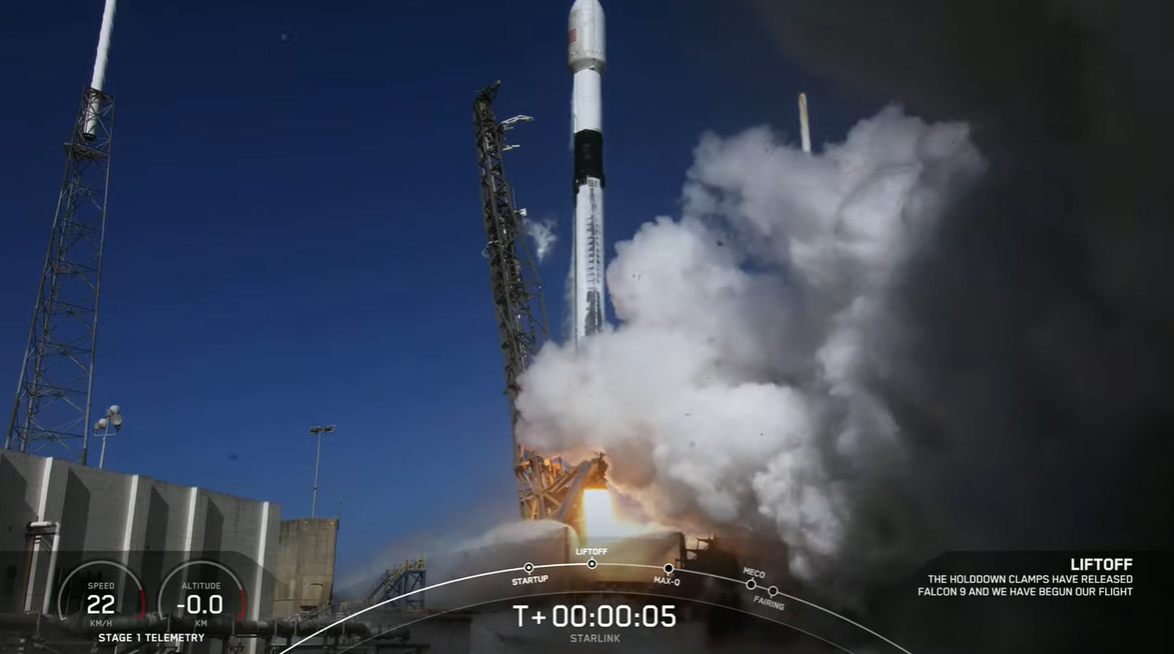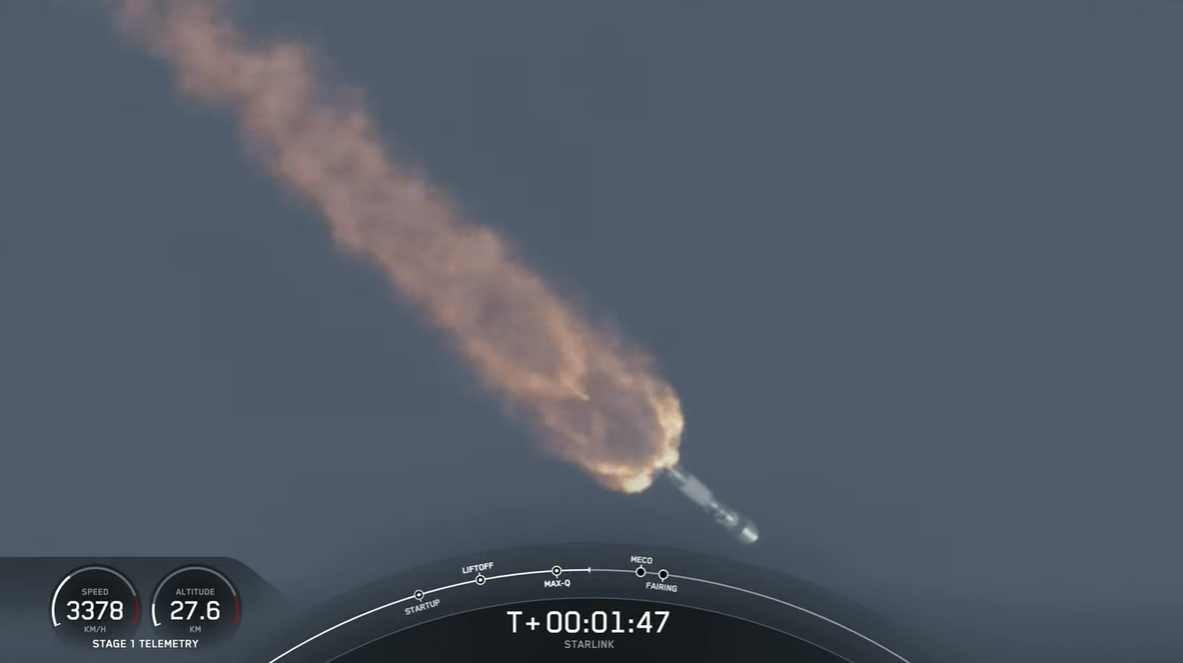SpaceX launches 46 Starlink satellites, lands Falcon 9 rocket for 100th time
SpaceX launched nearly four dozen satellites and landed the returning rocket Monday (Feb. 21) on a mission that tied the company's booster-reuse record.
A two-stage Falcon 9 rocket topped with 46 of SpaceX's Starlink broadband spacecraft lifted off from Cape Canaveral Space Force Station in Florida at 9:44 a.m. EST (1444 GMT), soaring into a clear, blue sky.
About nine minutes after liftoff, the Falcon 9's first stage came back down to Earth for a vertical touchdown on SpaceX's droneship A Shortfall of Gravitas, which was stationed in the Atlantic Ocean a few hundred miles off the Florida coast. It was the 100th Falcon 9 rocket landing for SpaceX and the company's 107th landing overall, including touchdowns by Falcon Heavy boosters. (The company aced its 100th overall landing back in December.)
"Great news overall, we are now awaiting the deployment of our 46 Starlink satellites which is scheduled to occur about an hour from now," SpaceX production manager Jessie Anderson said during live commentary after the launch. SpaceX ended its live webcast before satellite deployment due the lack of ground station video links with the satellites, Anderson added.
Related: SpaceX's Starlink satellite megaconstellation launches in photos




Monday's flight was the 11th launch and landing of this particular Falcon 9 first stage, Anderson said. That tied SpaceX's reuse record, which was set by a different Falcon 9 booster during a Starlink launch in December.
The Falcon 9 first stage on this flight, called Starlink 4-8, previously launched SpaceX's Crew Demo-2 flight (the company's first astronaut flight for NASA in 2020), as well as the Anasis-II satellite mission for South Korea, CRS-21 space station cargo mission for NASA, Transporter-1 and Transporter-3 rideshare missions and five different Starlink missions, SpaceX has said.
Breaking space news, the latest updates on rocket launches, skywatching events and more!
The two halves of the rocket's nose cone, or payload fairing, also made return trips to space on the flight, each flying on their third mission, Anderson said.
"Improvements on the fairings and our overall refurbishment process has decreased the impact of water landings handled to an overall fairing recovery rate of 93% over the last 14 missions," she added.


SpaceX had already launched three big Starlink batches this year — two in January and one on Feb. 3. The Feb. 3 mission ran into serious trouble, however, thanks to a solar eruption, which triggered a geomagnetic storm here on Earth.
That storm increased atmospheric density, boosting drag on the newly launched Starlink satellites. As a result, up to 40 of the 49 spacecraft came crashing back to Earth, SpaceX representatives said.
SpaceX is apparently targeting a higher orbit in which to release its new Starlink satellites on today's flight, according to Spaceflight Now, which reduced the number of satellties from 49 to 46. They will be deployed in a near-circular target orbit that will range between 202 miles and 209 miles (325-337 kilometers) at its highest and lowest points, Spaceflight Now reported.
The lowest altitude for the satellites lost in the solar storm was about 130 miles (210 km), SpaceX has said. The company intentionally deploys its large batches of Starlink satellites into low orbits so that they can fall back to Earth and burn up in the atmosphere to avoid creating space debris if they suffer a malfunction in orbit.
SpaceX has already launched about 2,100 Starlink satellites to orbit, with more than 200 falling from orbit from failures or decommissioning, according to Spaceflight Now. But the company is far from done. SpaceX has approval to launch 12,000 Starlink craft and has applied for permission from an international regulator for up to 30,000 more.
The company's Starlink internet satellite project aims to provide high-speed internet access to customers anywhere on Earth, especially in underserved or extremely remote areas of the planet where internet service is difficult to obtain.
Monday's launch was originally scheduled for Sunday (Feb. 20), but SpaceX pushed it back a day due to bad weather for rocket recovery operations.
The successful launch and landing marked SpaceX's seventh space mission of 2022 and the fourth dedicated to Starlink launches. It was the company's 38th Starlink mission and 145th launch overall, Anderson said.
Editor's note: This story was updated at 10:32 a.m. EST to report the successful launch of SpaceX's Starlink 4-8 mission. It was also corrected to note that the mission carried 46 Starlink satellites into orbit, not 49.
Mike Wall is the author of "Out There" (Grand Central Publishing, 2018; illustrated by Karl Tate), a book about the search for alien life. Follow him on Twitter @michaeldwall. Follow us on Twitter @Spacedotcom or on Facebook.

Michael Wall is a Senior Space Writer with Space.com and joined the team in 2010. He primarily covers exoplanets, spaceflight and military space, but has been known to dabble in the space art beat. His book about the search for alien life, "Out There," was published on Nov. 13, 2018. Before becoming a science writer, Michael worked as a herpetologist and wildlife biologist. He has a Ph.D. in evolutionary biology from the University of Sydney, Australia, a bachelor's degree from the University of Arizona, and a graduate certificate in science writing from the University of California, Santa Cruz. To find out what his latest project is, you can follow Michael on Twitter.
